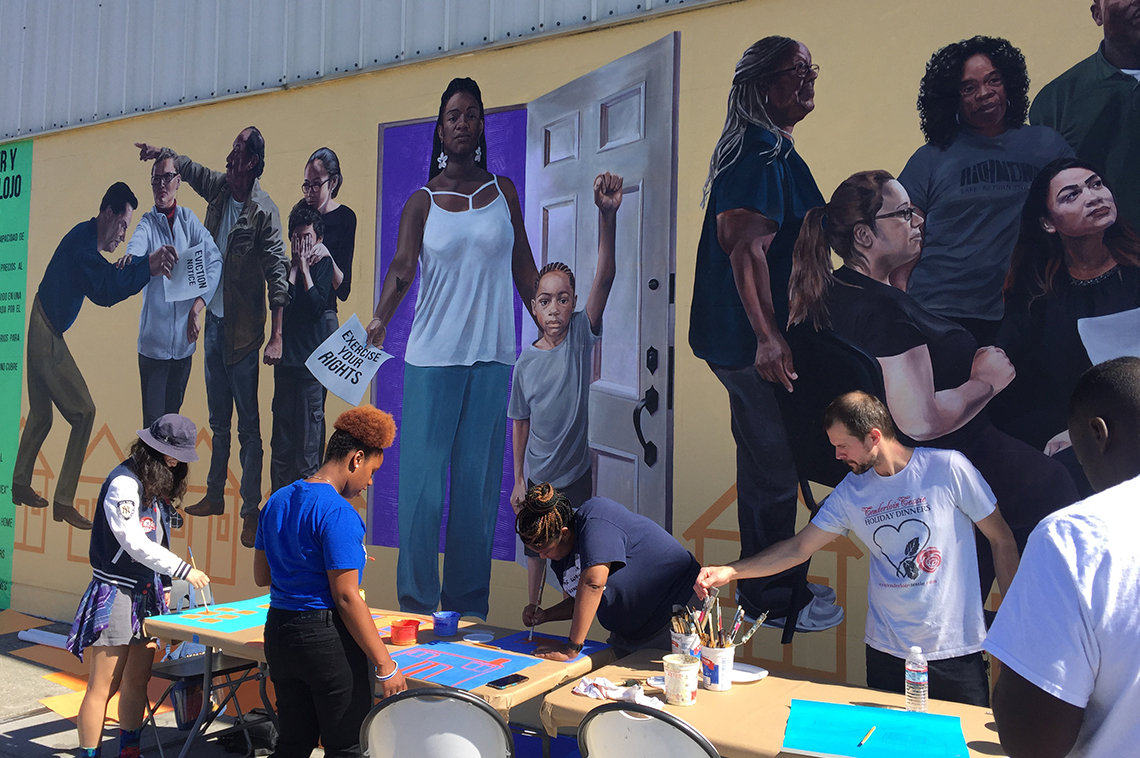
This session took place on May 22, 2018 at the ArtPlace 2018 Annual Summit in Louisville, Kentucky.
“What makes the difference between arts and culture strategies that encourage belonging and those that encourage separation?” asked organizer and activist Sasha Graham of the Alliance of Californians for Community Empowerment (ACCE).
Her introductory question was one of the core topics explored during the session Anti-Displacement Strategies, which was co-facilitated by Graham and Eli Moore, program manager of the Haas Institute for a Fair and Inclusive Society at the University of California, Berkeley. Graham and Moore are two of the artists and organizers behind Staying Power, an arts, policy, and participatory action research fellowship coordinated by ACCE, the Haas Institute, RYSE, and the Safe Return Project.
The learning-and-working session was a chance for participants to exchange knowledge and ideas with their peers about some of the creative ways displacement is being counteracted on local, regional, and national scales in the United States today.
Graham and Moore began by introducing attendees to Staying Power’s history. As Richmond gentrifies, they explained, its historically Black population is being rocked by displacement. Efforts toward rent control, just cause for eviction, “Ban the Box,” and $15 minimum wage have done some good, but more is necessary. Enter Staying Power.
Its paid fellowship program tasked six emerging Richmond leaders from the project’s coordinating organizations with researching the history of their city, interviewing scores of residents, and examining what other cities are doing about displacement—and why those efforts are working (or not). The 2017 fellows performed a collective poem at the Richmond Citywide Housing Symposium and other public events, facilitated writing workshops for resident kids about housing and belonging, drafted new housing-related city ordinances, and much more.
Moore said that many local organizations had rallied for this type of comprehensive, ‘bottom-up’ approach to building civic power. “Arts were a big part of this process—more so than the outcome,” he said. Nodding to Graham’s initial question, he explained that murals, for example, have become a sign of gentrification, so the fellows approached the subject of designing a community mural carefully—though they recognized the importance of employing art in their work.
“Extreme economic inequality is what’s really shaping gentrification,” he said. “The coffee shops, bike lanes, murals, and trees are just the artifacts. We wanted to build up the capacity for this work in community organizations so that the ideas came from within. We wanted to go from individual experiences to fellows’ shared experiences to community experiences.”
“Many people in our communities don’t know about power structures,” Graham said. “They don’t know what’s happening until they get that eviction notice, and then they’re not calling a lawyer. They don’t know there’s something they can do about their displacement, that there are protections. They just go. So being able to educate people has been really empowering.”
When an audience member asked how Staying Power used the arts to help them promote fair housing policies, Moore replied that reading the group’s collective poem at a city council meeting was “a powerful way to express to [council members] how their community is feeling and what they’re going through. Also, using ‘humanities methods’ helps the community learn about what rights and options they have.”
Graham and Moore listed the “4 P’s” that much of the fellows’ work fell under:
- Production (e.g., more affordable housing; affordable housing bonds; public land policies)
- Preservation (e.g., preserving existing affordable housing; bolstering voucher programs and source of income discrimination protections; taxing speculative real estate investments)
- Protection (e.g., protecting those vulnerable to eviction through a reusable tenant screening ordinance; preventing and reducing absentee landlordism)
- Power (e.g., founding organizations like Richmond Community-Owned Development Enterprise, which centers community needs and vision instead of handing control off to developers)
For the remainder of the session, the facilitators asked participants to join one of three breakout groups: Fundraising, Policy, or Arts Strategies. Each person was asked to share one resource with their group, and ask one question.
The resulting exchanges generated much more information than could be shared in a single blog post and we will be updating this blog with a list of highlights of resources mentioned. Stay tuned!





